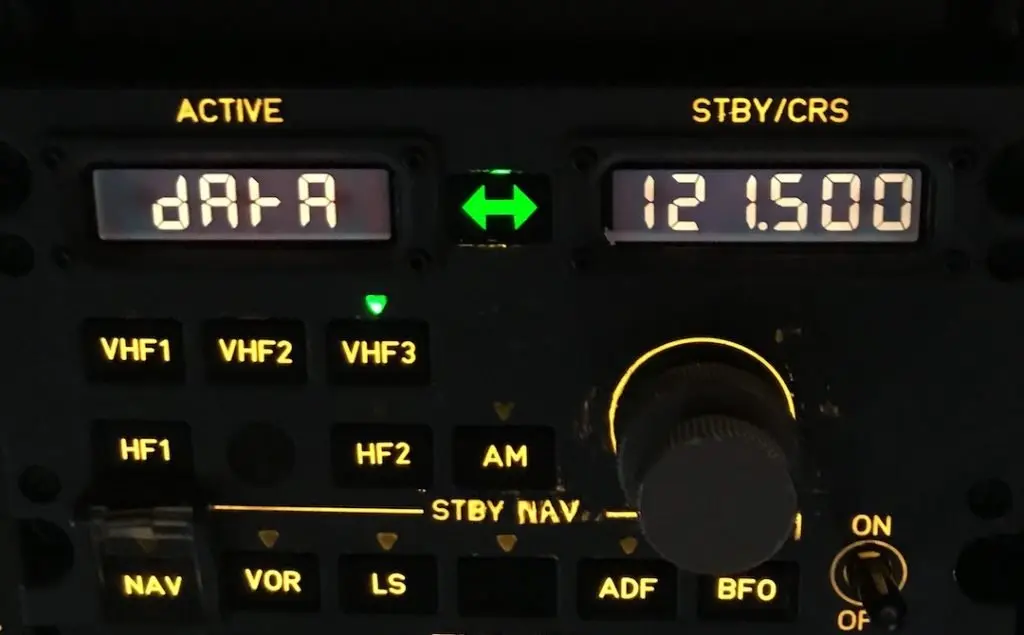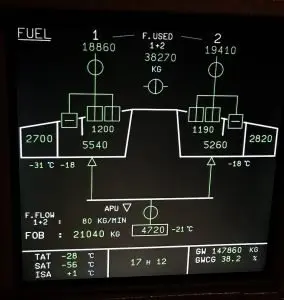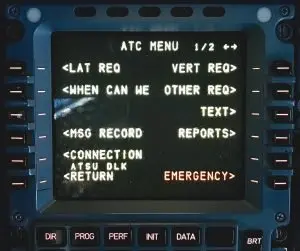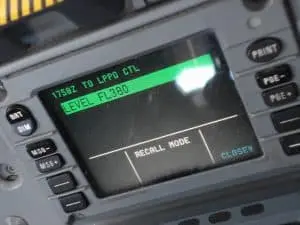I may earn a small commission from links on this page, but I only recommend quality products I trust.

Pete has been flying aircraft for the last 20 years. He has flown everything from light piston aircraft up to heavy jets as both First Officer and Captain. He’s currently enjoying life flying the Airbus A330 for a major international airline.
ACARS (Aircraft Communications, Addressing and Reporting System) is a digital communication system used on aircraft that allows messages to be sent and received in text format between aircraft and ground stations.
Table of Contents

How does ACARS work?
ACARS allows text-based messages to be sent between aircraft and other stations, for example OOOI messages to airline dispatch or maintenance departments, or to request up to date weather reports while in flight.
Datalink Service Providers (DSPs – for examples SITA or ARINC) are responsible for the transmission of messages between stations.
ACARS messages are received on the aircraft by one of three methods:
- VHF (Very High Frequency) – this is for short-range communication limited by line of sight. Also referred to VHF Data Link (VDL).
- HF (High Frequency) – HF Data Link (or HFDL) functions at long-range including over the ocean and in polar regions.
- SATCOM (Satellite Communication) – SATCOM links are available in most places on the planet except in polar regions.
There are three types of ACARS messages:
- Air Traffic Control (ATC) – the most common use of ACARS with ATC is for clearances such as Pre Departure Clearance (PDC) and Oceanic Clearance (OCX). Also D-ATIS (Digital Automatic Terminal Information System) falls under the ATC function.
- Aeronautical Operational Control (AOC) – the AOC function of ACARS is used regularly during a typical flight by the pilots to receive the load sheet prior to departure, to obtain updated weather reports enroute, to report delays to dispatch or even request updated flight plans (for example if a planned cruising altitude is unavailable). ACARS also provides a way of instantly updating dispatch in the event of a diversion or emergency. The AOC function also includes automatic reporting of engine health and any ECAM warnings to the airline maintenance department, reporting of flight times (OOOI), gate assignments etc.
- Airline Administrative Control (AAC) – The AAC functions to provide relevant admin information such as the PIL (Passenger Information List) which contains information such as passenger connections, available seats etc.
Normally when a message is received on the flight deck its automatically printed out on a printer on the center console. Pilots can then used the FMS (Boeing) or MCDU (Airbus) to type a reply or request further information.
Learn about ACARS OOOI messages here.
How to Receive ACARS
On a typical flight we send and receive messages through the MCDU or FMS, but it’s also possible to receive ACARS messages on a regular PC or Raspberry Pi mini computer.
Although more of an “intermediate level project” than something for a beginner it’s relatively straightforward to do with a Software Defined Radio (SDR) usb dongle and some software. The cheap RTL-SDR dongle (Check Price on Amazon) was originally intended for people to receive TV broadcasts onto their computers, clever people have adapted its use. It has a wide frequency spectrum and covers the aviation frequencies necessary to receive ACARS.
In addition to the dongle, decoding software such as Plane Plotter or Acarsdeco2 is used to decode the received messages.
Combining the software defined radio mentioned above with software such as SDR# (“SDR Sharp”) can even allow you to listen in to aircraft voice communications.
Heres a video example of ACARS reception with the SDR dongle:

The 5 Best Aviation Audiobooks (Chosen by a Pilot) A list of the best aviation audiobooks chosen by a current airline pilot. From fascinating stories at the dawn of aviation to modern day aircraft accidents.
An example of ACARS use on a flight
During the preflight phase the ACARS will be used to request the latest ATIS (D-ATIS) to plan the expected departure and calculate the take-off performance. Often a request for the latest weather at the destination is also made for the public address (we all like hearing our destination is sunny!).
With the latest ATIS in hand a Pre Departure Clearance (PDC) request will be sent to ATC with our aircraft type, the ATIS received and our gate number.
Once we’ve decided on our final fuel a request will be sent to the load planning department with our figures requesting a load sheet, which will print out automatically once it arrives (usually STD-10 i.e. 10 minutes before our departure time).
Throughout the flight various automated messages (such as OOOI messages, automated reports to maintenance control etc.) will be sent to the airline’s operations department.
Airborne, apart from the routine requests for enroute and destination weather, ACARS will be busy sending dispatch updates of our position and ETA at destination, and keeping maintenance informed about any ECAM/EICAS warnings or cautions we’ve received.
Approaching our ocean crossing point we’ll send our OCX (Oceanic Clearance Request) with our requested cruising flight level (depending on forecast turbulence and aircraft weight).
Learn how pilots try to avoid turbulence during flight.
Approaching our destination we’ll be busy sending updates to dispatch and requesting our expected parking position, and also sending any information about passenger assistance requirements for PRMs (Passengers with Reduced Mobility).
And, lastly, at the gate, on the way out the door we’ll print off the flight times – another exciting flight in the logbook.

The 5 Best Aviation Audiobooks (Chosen by a Pilot) A list of the best aviation audiobooks chosen by a current airline pilot. From fascinating stories at the dawn of aviation to modern day aircraft accidents.
Youtube Video example of ACARS
Here is a video example of ACARS use on a flight deck of Boeing 747 requesting Oceanic Clearance for Shanwick.
History of ACARS
Prior to the implementation of digital communication in aircraft, all communication was down by voice over VHF or HF (long range) radio.
As many things in aviation depended on accurate timings (including pilot pay!), airlines identified the need for accurate, up to date digital communications from aircraft and so, in 1978, ACARS was introduced by the engineering department in ARINC.
ARINC (Aeronautical Radio, Incorporated) which was a major provider of transportation communications systems (ARINC was sold in 2013 to Rockwell Collins).
ACARS originally stood for “Arinc Communications Addressing and Reporting System” but this was later changed to what we now know as “Aircraft Communications, Addressing and Reporting System”
What frequencies does ACARS use?
| Datalink Service Provider (DSP) | Frequency |
| ARINC America | 131.550 MHz |
| SITA North America | 136.850 MHz |
| SITA Latin America | 131.725 MHz |
| ARINC Europe | 136.925 MHz |
| SITA Europe | 131.725 MHz |
| ARINC Africa | 126.900 MHz |
| ARINC Asia | 131.450 MHz |
| ARINC Korea | 131.725 MHz |
| SITA Pacific | 131.550 MHz |
| DEPV Brazil | 131.550 MHz |
| AVICOM Japan | 131.450 MHz |
Further Reading on ACARS
Further reading on ACARS:
Learn the differences between ACARS and CPDLC.
ICAO: Introduction to ACARS Messaging Services
Frequently Asked Questions About ACARS
What does ACARS stand for?
ACARS stands for Aircraft Communications, Reporting and Addressing System.
What is ACARS used for?
ACARS is used by pilots to request updated weather, Air Traffic Control clearances and to communicate with dispatch. Airlines use ACARS to keep up to date on aircraft movements and engine health.
How do you pronounce ACARS?
ACARS is pronounced AY-CARS.
What are the three types of ACARS messages?
The three types of ACARS message are Air Traffic Control (ATC), Airline Operational Control (AOC) and Airline Administrative Control (AAC).
What are the three data link methods?
The three data link methods are VDL (Very Hight Frequency Data Link), HFDL (High Frequency Data Link) and SATCOM (Satellite Communications).
What does ACARS mean?
ACARS (Aircraft Communications, Reporting and Addressing System) is a system that allows communication in text form between pilots and airlines, Air Traffic Control etc.

Pete has been flying aircraft for the last 20 years. He has flown everything from light piston aircraft up to heavy jets as both First Officer and Captain. He’s currently enjoying life flying the Airbus A330 for a major international airline.






